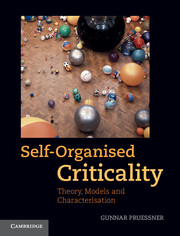Book contents
- Frontmatter
- Contents
- List of tables
- Foreword by Henrik J. Jensen
- Preface
- List of symbols
- Part I Introduction
- Part II Models and numerics
- 4 Deterministic sandpiles
- 5 Dissipative models
- 6 Stochastic sandpiles
- 7 Numerical methods and data analysis
- Part III Theory
- Appendix: The OLAMI–FEDER–CHRISTENSEN Model in C
- Notes
- References
- Author index
- Subject index
7 - Numerical methods and data analysis
from Part II - Models and numerics
Published online by Cambridge University Press: 05 September 2012
- Frontmatter
- Contents
- List of tables
- Foreword by Henrik J. Jensen
- Preface
- List of symbols
- Part I Introduction
- Part II Models and numerics
- 4 Deterministic sandpiles
- 5 Dissipative models
- 6 Stochastic sandpiles
- 7 Numerical methods and data analysis
- Part III Theory
- Appendix: The OLAMI–FEDER–CHRISTENSEN Model in C
- Notes
- References
- Author index
- Subject index
Summary
This chapter describes a number of (numerical) techniques used to estimate primarily universal quantities, such as exponents, moment ratios and scaling functions. The methods are applied during post-processing, i.e. after a numerical simulation, such as the OFC Model, Appendix A, has terminated. Many methods are linked directly to the scaling arguments presented in Ch. 2, i.e. they either probe for the presence of scaling or derive properties assuming scaling.
A time series is the most useful representation of the result of a numerical simulation, because it gives insight into the temporal evolution of the model and provides a natural way to determine the variance of the various observables reliably. Most of the analysis focuses on the stationary state of the model, where the statistics of one instance of the model with one particular initial state is virtually indistinguishable from that with another initial state. The end of the transient can be determined by comparing two or more independent runs, or by comparing one run to exactly known results (such as the average avalanche size) or to results of much later times. The transient can be regarded as past as soon as the observables are within one standard deviation. It pays to be generous with the transient, in particular when higher moments or complex observables are considered.
In the stationary state, the ensemble average (taking, at equal times, a sample across a large number of realisations of the model) is strictly time independent.
- Type
- Chapter
- Information
- Self-Organised CriticalityTheory, Models and Characterisation, pp. 210 - 240Publisher: Cambridge University PressPrint publication year: 2012

